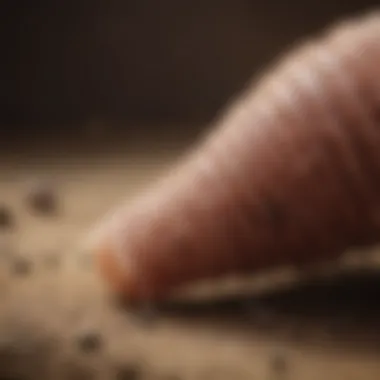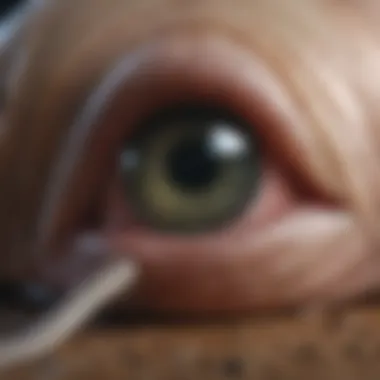Understanding Hookworm Transmission in Dogs


Intro
Hookworms are sneaky little critters that can pose a major health threat to our canine companions. Understanding how these parasites sneak into the lives of dogs is essential for prevention and overall well-being. This discussion dives into the transmission pathways of hookworms, broadening awareness for dog owners, pet lovers, and even veterinary professionals.
We will paint a clear picture of the lifecycle of these parasites and explore how various environmental factors affect their spread. In addition, preventive measures will be discussed, aiming to arm pet stakeholders with knowledge for better canine health management.
Animal Overview
Common Name and Scientific Classification
The hookworm, commonly referred to as Ancylostoma caninum, belongs to a family of parasitic nematodes. These minuscule worms seem innocent enough until one realizes their capacity to cause serious health issues in dogs.
Physical Characteristics
Hookworms are typically tiny, measuring between 0.5 to 1 inch in length. They possess a pointed head and a distinctive hook shape, which helps them latch onto the intestinal wall of their host. Their bodies are smooth and can be transparent, making them quite elusive when it comes to medical diagnosis.
Habitat and Distribution
These pests love warmth and moisture, often thriving in sandy soils. They are primarily found in southern regions but can spread as far as northern areas during warmer seasons. Dog owners in subtropical and tropical climates should be especially cautious, as hookworms can be a common concern in these environments.
Lifecycles and Transmission Modes
Hookworms have a fascinating yet alarming lifecycle. Adult hookworms live in the intestines of their canine hosts, where they feed on blood. Their eggs are excreted in feces, developing into larvae in the soil. Transmission can occur via direct skin contact with these larvae, ingestion, or even through maternal transmission during pregnancy or breastfeeding.
Environmental Factors Influencing Transmission
Several environmental factors contribute to the effective transmission of hookworms:
- Warm Temperatures: The larvae thrive in moist, warm conditions; heavy rainfall can create ideal habitats.
- Poor Sanitation: In areas where dogs roam freely, fecal contamination becomes rampant, providing a breeding ground for hookworm larvae.
- Wildlife Interference: Stray dogs and wild animals can act as reservoirs for the parasites, complicating control efforts.
Preventive Measures for Dog Owners
Prevention is always better than cure! Here are some practical tips to keep your canine safe from hookworms:
- Maintain Cleanliness: Regularly clean up after your dog to minimize soil contamination.
- Routine Worming: Follow veterinary advice for deworming schedules appropriate for your dog's age and health status.
- Regular Vet Check-ups: Routine fecal exams can help detect hookworms early, facilitating timely treatments.
"An ounce of prevention is worth a pound of cure."
With diligent care and awareness, we can minimize the risks associated with these pesky parasites, ensuring that our furry friends remain healthy and robust.
Closure
Understanding Hookworms
In the context of canine health, comprehending the nature of hookworms is paramount. These parasites are not merely nuisances; they pose a significant risk to the well-being of dogs. By understanding the characteristics and behaviors of hookworms, pet owners, veterinarians, and wildlife biologists can better safeguard their furry companions against potential infestations. With thousands of cases documented, the impact of these parasites on dog populations cannot be overlooked. This section sets the foundation for a detailed examination of how hookworms thrive, their lifecycle, and their transmission pathways.
Defining Hookworms
Hookworms are parasitic roundworms belonging to the family Ancylostomatidae. Unlike other intestinal parasites, they have specialized mouthparts that allow them to attach to the intestinal walls of their hosts. The species most commonly affecting dogs include Ancylostoma caninum and Uncinaria stenocephala.
These worms exhibit a unique shape that resembles a hook, hence the name. They can be quite small, with adult worms measuring about 1 to 2 centimeters in length. While they might not be visible to the naked eye, their presence can lead to a range of health issues in dogs, including anemia, lethargy, and in severe cases, death.
Types of Hookworms Affecting Dogs


Hookworms are not a monolithic group; they come in various forms, each with distinct characteristics and effects on dogs:
- Ancylostoma caninum: This species is prevalent in warmer climates and is particularly notorious for causing severe anemia. It's often transmitted through skin contact, making it a significant concern for dogs that roam outside.
- Uncinaria stenocephala: More commonly found in cooler regions, this type is less pathogenic than Ancylostoma caninum but still poses a risk to canine health. It generally leads to less severe symptoms but can still contribute to dietary deficiencies over time.
- Ancylostoma braziliense: Known as the southern hookworm, this species may cause similar symptoms to Ancylostoma caninum but is less frequently encountered. It can also infect humans, leading to cutaneous larva migrans.
Each type of hookworm presents its challenges and requires targeted management and prevention strategies to ensure the health of canine populations. As the transmission of these parasites can be influenced by various factors, including environment and lifestyle, understanding the differences and potential impacts is crucial for effective prevention and treatment.
Lifecycle of Hookworms
Understanding the lifecycle of hookworms is crucial in tackling the parasitic threats they pose to canines. Grasping this cycle not only sheds light on the complexity of their existence, but also lays the groundwork for effective prevention and treatment strategies. Hookworms can be quite the nuisances for dogs—leading to discomfort and potential health complications. When pet owners and veterinarians understand how these parasites thrive and reproduce, they can take informed steps to break the cycle of infection.
The lifecycle includes various stages that unfold both outside and inside the host dog, making effective intervention more challenging. Each phase offers insight into where dogs may become infected, and thus informs the groundwork for better preventive measures. Recognizing the stages involved in developing a strategy against these hosts is key to keeping our canine friends safe and healthy.
Eggs and Larvae in the Environment
Hookworm eggs are typically excreted in the feces of infected canines. Once in the environment, these eggs hatch into larvae under suitable conditions—namely, warm, moist soil. The larvae then enter either a free-living stage or develop into an infective form. Understanding the environmental requirements is vital, particularly when focusing on preventive care.
- Ideal Conditions for Development:
- Warm, moist soil promotes egg hatching.
- Overcrowded living conditions facilitate the spread of eggs and larvae.
- Shade can also enhance larvae survival, so damp regions of yards or parks are often breeding grounds.
These larvae linger in the environment, waiting for a suitable host. It is worth noting that the larval form can survive for several months, increasing the chances of transmission. Therefore, any area where dogs frequent can potentially harbor these infective larvae, raising the stakes for pet owners. It underscores the importance of maintaining clean environments to limit exposure.
Transmission to Canines
Once larvae are in the environment, canines can be infected through two primary methods: ingestion or skin penetration. This duality in transmission is what makes hookworms particularly troublesome. The oral ingestion occurs when dogs accidentally swallow infective larvae, usually through contaminated soil, grass, or even water. Just a little cursory sniff of the wrong corner of the yard can spell trouble for an unsuspecting pup.
On the other hand, skin penetration happens more directly. Larvae can enter a canine's bloodstream through the skin—commonly the paws. You might think your dog is just out for a casual stroll, unaware they could be picking up these unwelcome hitchhikers along the way.
- Modes of Transmission:
- Ingestion: Often occurs in areas that are contaminated with the feces of infected dogs.
- Skin Penetration: Larvae can burrow into the skin, especially if the dog walks in infected areas.
Modes of Transmission
Understanding the various modes through which hookworms spread among canines is crucial. This knowledge helps dog owners and caretakers take proactive measures and ensure their pets remain healthy. As canines interact with different environments and other animals, awareness of these transmission pathways can significantly reduce infestation rates. Comprehensive education on these modes equips pet proprietors with practical strategies to limit exposure, ultimately promoting the well-being of their dogs.
Oral Ingestion of Larvae
Hookworms find their way into a dog's system primarily through oral ingestion of larvae. This occurs when a dog unknowingly consumes contaminated soil, grass, or even food. The larvae are resilient critters, capable of surviving in harsh conditions until a suitable host comes along. Once ingested, the larvae travel through the digestive system, where they attach themselves to the intestinal walls, leading to potential health issues for the dog.
Hookworm larvae can remain infectious for long periods in the environment, making vigilance essential for dog owners.
This mode of transmission can often happen during outdoor activities—when dogs are sniffing various surfaces or scavenging for edible items. Thus, it is important to keep an eye on what your dog is chewing. Additionally, maintaining a clean environment where the pet roams can significantly curtail the likelihood of oral transmission.
Skin Penetration by Larvae
Another significant transmission route for hookworms in canines is through skin penetration. The larvae can directly invade a dog’s skin, especially through areas that are moist or damaged. When dogs come into contact with contaminated soil—think of a dog digging in a yard or running through a field—the hookworm larvae can latch onto their skin. This is often more prevalent during warm, humid weather when larvae are most active and abundant.
Once the larvae penetrate the skin, they make their way into the dog’s bloodstream. From there, they can wander through the body, eventually settling in the intestines. It’s a rather stealthy approach, making it hard for pet owners to realize that their dog has been infected. This emphasizes the importance of regularly checking your dog’s skin for any signs of irritation or unusual behavior that could indicate discomfort or health issues.
Transmission from Mother to Puppies
The transmission of hookworms can also occur from mother to her puppies. This can happen during pregnancy or while nursing. In utero, hookworms can migrate from the mother’s system into the developing puppies. They can also be transferred through the mother’s milk after the puppies are born, leading to early infestations. Such a route of transmission raises significant concern because puppies are often more vulnerable due to their developing immune systems.
As a result, fostering awareness of the potential for maternal transmission is vital for new dog owners. Regular veterinary check-ups, appropriate deworming protocols, and monitoring the health of the mother and her litter are crucial steps in safeguarding the next generation of dogs from these parasitic intruders. Investing in preventive measures at this stage can lead to healthier dogs in the long run.


Environmental Factors That Influence Transmission
Geographical Variations
Geographical conditions play a crucial role in the transmission pathways of hookworms. In areas with warm climates, for instance, there tends to be a higher rate of hookworm infestation due to favorable conditions for the larvae's survival and development. Southern states in the United States, such as Florida and Texas, typically report more hookworm cases compared to northern states where the climate is harsher and less conducive to the larvae's lifecycle.
"Where you live can dictate how likely it is for your dog to encounter hookworms. The environment isn't just background - it's the stage where a crucial drama unfolds."
In more humid regions, the survival rate of hookworm larvae often increases as moisture facilitates their survival in the soil and other substrates. Moreover, areas with higher populations of stray and feral dogs can amplify the risk of transmission, as these animals serve as reservoirs for the parasites. Healthier pets in communities with poor veterinary care access may unknowingly spread the infestation, creating a cyclical problem that’s hard to break.
Understanding these geographical patterns can greatly assist in developing targeted strategies for prevention and treatment. Dog owners in high-risk areas may be advised to take extra precautions, such as regular deworming and ensuring good hygiene practices to control the risk of transmission.
Seasonal Changes and Transmission Rates
Seasons can have a dramatic impact on hookworm transmission rates. The warm and wet seasons typically see a rise in larval activity and survivability. During spring and summer, temperatures are conducive to the growth and proliferation of hookworms, and they thrive in moist conditions. This can lead to increased cases of canine hookworm infection during these times.
In contrast, the colder months may not completely eradicate the threat but can reduce it significantly. Frosty temperatures and dry conditions can decrease the larvae's lifespan, leading to a drop in infection rates. However, hookworm eggs need a specific amount of moisture to hatch, and these eggs can withstand harsh conditions in the soil for some time, waiting to reinfect animals when conditions improve.
Thus, pet owners and caretakers need to be particularly vigilant during warmer months. They should educate themselves about their local conditions and remain observant for any signs of hookworm infestation in their pets, especially during seasons known for higher rates of transmission. Regular veterinary advice on seasonal treatment routines can be an effective measure in controlling infestations.
By holistically comprehending these environmental factors, dog owners can arm themselves with knowledge to help prevent hookworm infections and safeguard their canine companions from this pervasive threat.
Identifying Infection in Dogs
Identifying hookworm infection in dogs is crucial for the health and well-being of both the animals and their owners. Understanding how to recognize these infections can make all the difference in preventing long-term health issues. Early detection not only enables prompt treatment but also minimizes the risk of transmission to other animals and humans. The significance of identifying these infections cannot be understated, as hookworms can lead to serious complications if left unchecked.
Common Symptoms of Hookworm Infestation
Recognizing the common symptoms of hookworm infestation helps in taking early action. Dogs infected with hookworms may show a variety of signs. Here are some of the most prevalent symptoms:
- Anemia: Pale gums and lethargy often point towards blood loss, a consequence of hookworm feeding.
- Diarrhea: Often dark or tarry, this symptom arises from digestive issues caused by the parasites.
- Weight Loss: Despite a good appetite, dogs may lose weight due to nutritional deficiencies as hookworms absorb essential nutrients.
- Scratchy Skin or Rash: Some dogs exhibit allergic reactions or skin irritations from larvae penetration.
While these indications can suggest a hookworm problem, they can overlap with other health issues. Therefore, a careful observation is necessary to differentiate them.
Diagnosis Through Veterinary Testing
If you suspect that your dog may be infected with hookworms, it’s important to consult a veterinary professional for an accurate diagnosis. Common veterinary testing methods include:
- Fecal Examination: A stool sample is analyzed to identify the presence of hookworm eggs.
- Blood Tests: These tests can assess the degree of anemia and possibly reveal the presence of specific antigens.
- Physical Examination: Your vet will check for physical symptoms during an examination, which can provide indicative clues.
"Early diagnosis is key to avoiding serious health consequences for your pet."
Veterinary professionals may recommend further tests if the initial assessments indicate a hookworm infection. Understanding these diagnostic pathways aids in ensuring that your canine companion receives timely and appropriate care.
Treatment Options
Understanding the treatment options available for hookworm infestation in canines is crucial not only for recovery but also for preventing further health issues. Treating hookworms effectively can eradicate the parasites, alleviate symptoms, and ensure that the infected dogs bounce back to their normal, boisterous selves. Furthermore, it offers peace of mind for guardians, knowing that proactive measures are taken to safeguard their furry family members. Choosing the right course of action can significantly impact the overall health of a dog and the household environment, as it minimizes the chance of reinfection or transmission to other animals or even humans.
Medications for Hookworm Infestation
Administering the right medications is the first step in addressing a hookworm infestation in dogs. Commonly recommended antiparasitic drugs include fenbendazole, pyrantel pamoate, and moxidectin. Each of these medications works effectively but may vary in how quickly they act and their specific targets within the lifecycle of the hookworm.
- Fenbendazole: This broad-spectrum anthelmintic disrupts the metabolism of the hookworms, ultimately starving them. Typically, it’s given over a three-day period to target various stages of the worms effectively.
- Pyrantel Pamoate: This medication works by paralysis, allowing the dog to expel the worms naturally. It’s often used for routine deworming, making it a staple in many pet care regimens.
- Moxidectin: Besides targeting hookworms, this medication is also effective against heartworms and is typically administered via a topical application or injection. It provides protection while treating existing infestations.
Supportive Care for Infected Dogs


Providing supportive care alongside medication is essential for a dog recovering from hookworm infestation. While medications tackle the parasites, support aids in overall recovery. Here are some ways to ensure a dog's comfort and health during this process:
- Hydration: Ensure the dog has access to clean, fresh water. Proper hydration can help flush out toxins and assist in recovery.
- Nutrition: A nutritious diet is vital. Feeding a balanced diet rich in proteins can help boost the dog’s immune system and speed up recovery. When a dog is recovering from illness, easily digestible food is often best.
- Rest: Encourage the dog to rest. Limit physical activity to allow its body to focus energy on recovery, rather than exertion.
- Monitoring: Keep a close eye on the dog’s symptoms. If symptoms like lethargy, diarrhea, or vomiting persist or worsen, consult a veterinarian immediately.
"A well-rounded approach to treatment not only focuses on eliminating parasites but also strengthens the dog’s overall health, paving the way for a quicker and healthier recovery."
Choosing effective treatment and providing proper care presents a comprehensive strategy to combat hookworm infestations. Dog owners should stay in contact with their veterinarian to adjust treatment as necessary and ensure the most effective approach for each individual dog.
Preventive Measures for Dog Owners
Preventing hookworm infestations in canines is crucial for maintaining their health and well-being. The consequences of neglecting this can be serious, and understanding the preventive measures can take owners a long way in protecting their pets. Keeping this in mind, let’s delve into the various strategies that dog owners can implement.
Maintaining Clean Environments
A clean environment is the foundation of a good defense against hookworms. Regularly cleaning the yard and living areas will greatly minimize the risk of hookworm infection. It’s not just about aesthetics; it’s about health. Here are key considerations for maintaining a clean space:
- Regular Waste Disposal: Promptly removing dog feces is essential. Hookworm eggs can hatch into larvae that infect other animals or humans if left exposed.
- Cleaning Surfaces: Regularly wash any areas where the dog spends time, especially if they have come into contact with soil or yard debris.
- Dirt and Sand Areas: If your canine likes to dig or roll in the dirt, consider using non-contaminated sand or gravel that is less likely to harbor hookworm eggs.
Making these efforts creates a less inviting environment for hookworms, reducing the chances of transmission.
Regular Deworming Protocols
Implementing a deworming routine is like buying peace of mind. Regular deworming helps keep the hookworms at bay, preventing a full-blown infection. Consult with your veterinarian for an appropriate schedule that might typically involve:
- Initial Treatment: Puppies are often treated for hookworms early on, sometimes as young as two weeks old. This must be in accordance with veterinary advice.
- Annual Check-Ups: Adult dogs should be dewormed at least once a year. This is vital even if they do not show symptoms of infection. A stool sample test can be helpful in determining the need for treatment.
- Monitor Symptoms: Keep an eye on your dog's health, including changes in appetite or unusual behavior. Swift action can make all the difference.
Establishing this practice ensures that the risk of hookworms is managed proactively rather than reactively.
Educating Dog Owners about Transmission Risks
Knowledge is power, as they say. Educating oneself and others about how hookworms transmit can significantly impact the health of pets. Here are the key points that every dog owner should know:
- Understanding Transmission: Recognizing common transmission pathways, such as skin penetration or oral ingestion, helps in applying preventive measures effectively.
- Community Awareness: Speak with other dog owners. Share and learn about local areas that may have increased risk due to environmental factors such as high humidity.
- Resource Utilization: Use accessible educational resources. Websites like Wikipedia and platforms like Reddit may have community discussions that shed light on current issues.
"An ounce of prevention is worth a pound of cure.”
This adage rings true for hookworm transmission. The more informed dog owners are about potential risks, the better equipped they are to protect their pets, leading to healthier and happier lives.
By focusing on these preventive measures, dog owners not only safeguard their pets but also contribute positively to the community's overall canine health. Armed with the right knowledge and strategies, we can effectively reduce the threat posed by hookworms.
Epilogue
Understanding how hookworms are transmitted is not just an academic exercise; it's a crucial aspect of maintaining canine health. This article delves into various pathways through which these parasites spread, highlighting the importance of awareness and preventive measures for dog owners. Ignorance can lead to serious consequences, not only for the dogs but also for human family members who may come into contact with contaminated environments.
Summarizing Key Points on Hookworm Transmission
Several key factors surround the transmission of hookworms in canines. Firstly, the lifecycle of hookworms is complex, involving eggs and larvae that thrive in specific environmental conditions. This necessitates awareness surrounding environmental cleanliness: feces must be disposed of properly to minimize the risk of contamination.
Secondly, the various methods of transmission outlined in the article, such as oral ingestion and skin penetration, underscore the need for constant vigilance during a dog's outdoor activities.
- When dogs roam outside, they may inadvertently ingest larvae through contaminated water, food, or by sniffing around.
- Skin penetration is another common method; larvae can burrow into the skin, leading to infection.
Additionally, it's crucial for dog owners to understand that mother dogs can pass these parasites to their puppies, which can open up a whole new level of concern regarding early life exposure.
With the right knowledge, owners can take appropriate action:
- Regular deworming protocols.
- Keeping living areas clean and safe.
- Educating oneself about potential risks associated with hookworms.
In summary, tackling hookworm transmission requires a comprehensive understanding of its life cycle, awareness of environmental factors, and proactive measures. By doing so, dog owners safeguard not only the health of their pets but also that of everyone around them. For more information on canine hookworms, you can explore this Wikipedia article.
"An ounce of prevention is worth a pound of cure." Understanding these transmission pathways equips pet owners with the knowhow to prevent infestations before they occur.







